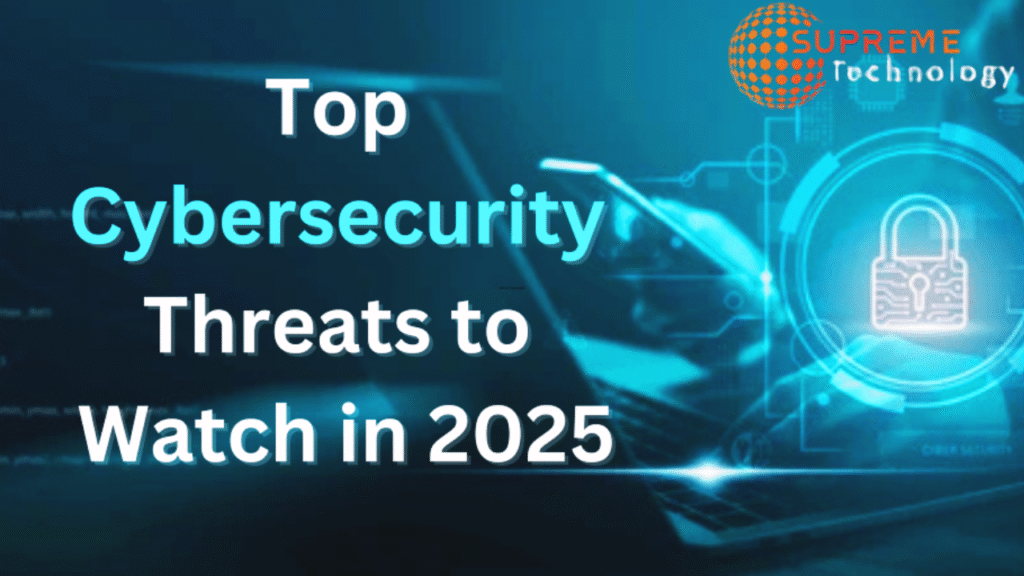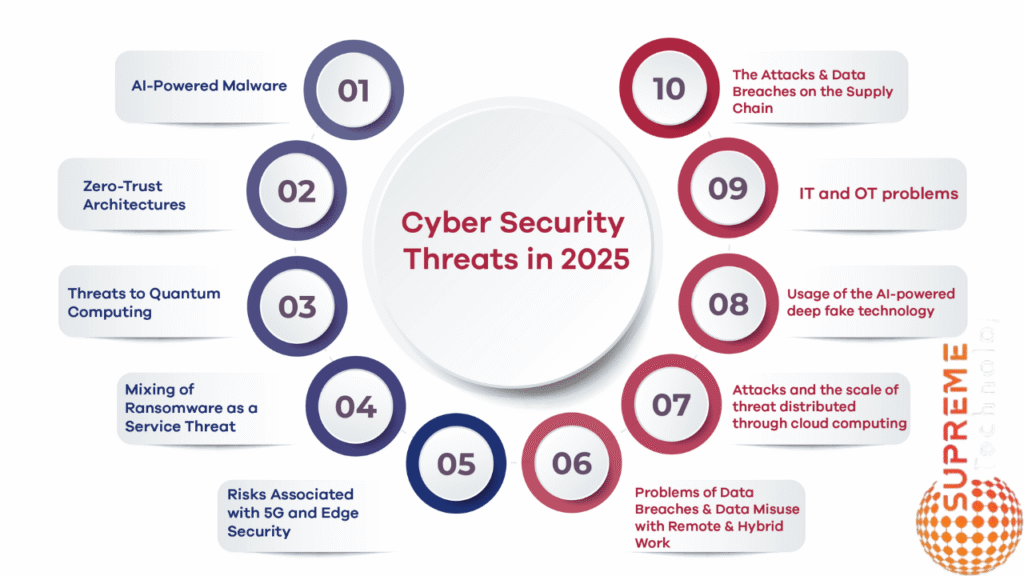As technology advances, so do the tactics of cybercriminals, making a critical concern for individuals, businesses, and governments. In 2025, emerging technologies like AI, quantum computing, and IoT introduce new vulnerabilities alongside evolving traditional threats. This article outlines the top 10 cyber security threats in 2025, their implications, and how to mitigate them.

What Defines a Cyber Security Threat?
A cyber security threat exploits vulnerabilities in systems, networks, or human behavior to steal data, disrupt operations, or cause harm. Key characteristics include:
- Sophistication: Use of advanced techniques like AI or zero-day exploits.
- Scale: Ability to target individuals, organizations, or entire industries.
- Impact: Potential for financial loss, data breaches, or reputational damage.
- Evolving Nature: Constant adaptation to bypass security measures.
Top 10 Cyber Security Threats in 2025
Based on recent analyses, industry reports, and expert insights, here are the top 10 cyber security threats for 2025:

1. AI-Powered Attacks
- Description: Cybercriminals leverage generative AI to create convincing phishing emails, deepfake videos, and automated malware that adapts to defenses. AI-driven attacks can bypass traditional detection systems.
- Impact: Increased success rates for social engineering and targeted attacks.
- Mitigation: Use AI-based security tools, enable multi-factor authentication (MFA), and train employees to spot deepfakes.
2. Ransomware-as-a-Service (RaaS)
- Description: RaaS platforms allow non-technical criminals to deploy ransomware, locking systems and demanding payment. In 2025, double-extortion tactics (data theft + encryption) are prevalent.
- Impact: Financial losses and operational downtime, especially for small businesses and critical infrastructure.
- Mitigation: Regular backups, patch management, and endpoint protection like Bitdefender or Norton 360.
3. Supply Chain Attacks
- Description: Attackers compromise third-party vendors or software supply chains to infiltrate larger organizations, as seen in past incidents like SolarWinds. Open-source software is a growing target in 2025.
- Impact: Widespread breaches affecting multiple organizations.
- Mitigation: Vet third-party vendors, use software bill of materials (SBOM), and monitor for suspicious activity.
4. Quantum Computing Threats
- Description: Advancements in quantum computing threaten to break current encryption standards (e.g., RSA, ECC). While not fully realized in 2025, “harvest now, decrypt later” attacks collect data for future decryption.
- Impact: Long-term risk to sensitive data like financial or medical records.
- Mitigation: Transition to post-quantum cryptography and monitor NIST guidelines.
5. IoT Device Exploits
- Description: The proliferation of IoT devices (smart home gadgets, industrial sensors) creates unsecured entry points. Weak passwords and unpatched firmware are common vulnerabilities.
- Impact: Botnets, data theft, or physical system disruptions (e.g., smart grids).
- Mitigation: Change default passwords, update firmware, and segment IoT devices on networks.
6. Cloud Misconfigurations
- Description: Misconfigured cloud services (e.g., AWS, Azure) expose data due to human error, such as open S3 buckets or weak access controls. Attackers exploit these to steal sensitive information.
- Impact: Data breaches and compliance violations (e.g., GDPR, HIPAA).
- Mitigation: Use cloud security tools, enforce least-privilege access, and conduct regular audits.
7. Zero-Day Exploits
- Description: Attackers target unknown vulnerabilities in software before patches are available. In 2025, zero-day exploits are sold on dark web markets, targeting browsers and operating systems.
- Impact: Widespread system compromises and delayed remediation.
- Mitigation: Deploy intrusion detection systems, keep software updated, and use sandboxing.
8. Social Engineering and Phishing
- Description: Phishing evolves with spear-phishing and smishing (SMS-based attacks) using AI to craft personalized lures. Business email compromise (BEC) remains a top threat.
- Impact: Credential theft, financial fraud, and unauthorized access.
- Mitigation: Employee training, email filtering, and MFA for all accounts.
9. 5G Network Vulnerabilities
- Description: Expanded 5G adoption increases attack surfaces, with risks in unsecure base stations and edge computing. Protocol weaknesses can enable eavesdropping or denial-of-service attacks.
- Impact: Disruption of critical services and data interception.
- Mitigation: Encrypt 5G traffic, monitor network anomalies, and adopt zero-trust architecture.
10. Insider Threats
- Description: Malicious or negligent insiders (employees, contractors) expose data through intentional leaks or errors. Remote work in 2025 amplifies risks due to unsecured home networks.
- Impact: Data breaches and reputational damage.
- Mitigation: Implement user behavior analytics, restrict access, and enforce data loss prevention (DLP) policies.
Warnings and Considerations
- Evolving Threats: Cybercriminals adapt quickly, so static defenses are insufficient. Regular updates and threat intelligence are critical.
- Regional Regulations: In regions with strict laws (e.g., China, Russia), using tools like VPNs to enhance security may face restrictions. Check local compliance.
- Free Tools Limitations: Free antivirus or VPNs often lack advanced protection. Invest in premium solutions like Bitdefender or NordVPN (details at https://www.bitdefender.com or https://nordvpn.com).
- Human Error: Many breaches stem from user mistakes. Ongoing training is essential to combat phishing and insider threats.
How to Protect Against These Threats
Choose security measures based on your needs:
- Comprehensive Protection: Use suites like Bitdefender Total Security or Norton 360 for malware and ransomware defense.
- Privacy Tools: Pair with a VPN (e.g., Proton VPN or NordVPN) for encrypted browsing (see https://protonvpn.com).
- Proactive Measures: Regular software updates, MFA, and employee training reduce vulnerabilities.
- Advanced Users: Implement zero-trust models and post-quantum encryption for future-proofing.
Conclusion
The cyber security landscape in 2025 is complex, with AI-powered attacks, ransomware, and emerging technologies like quantum computing and 5G driving new risks. By understanding the top 10 threats—AI attacks, RaaS, supply chain vulnerabilities, and more—you can take proactive steps to protect your data and systems. Invest in robust cyber security software, stay informed on evolving threats, and adopt best practices like MFA and regular backups to stay secure in a dynamic digital world.
